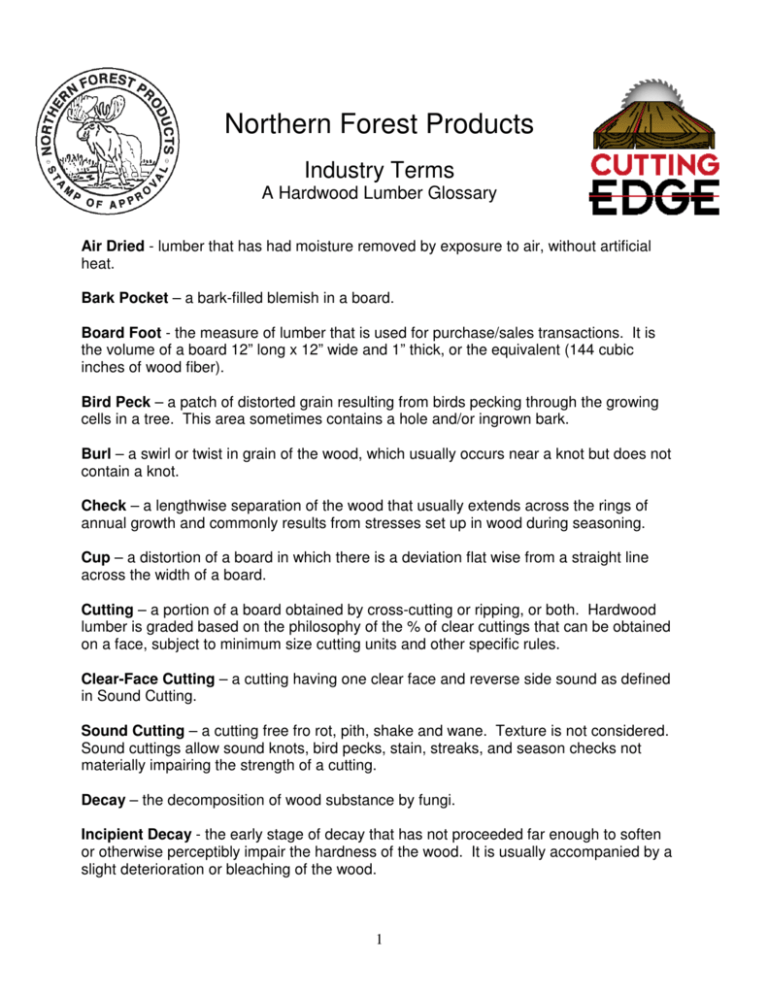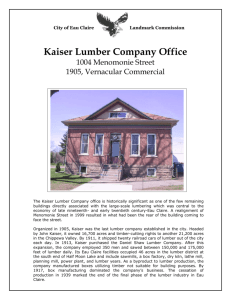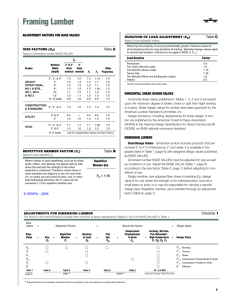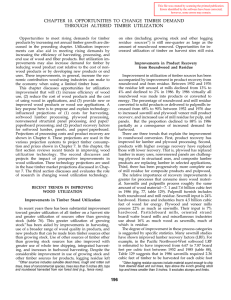Northern Forest Products
advertisement

Northern Forest Products Industry Terms A Hardwood Lumber Glossary Air Dried - lumber that has had moisture removed by exposure to air, without artificial heat. Bark Pocket – a bark-filled blemish in a board. Board Foot - the measure of lumber that is used for purchase/sales transactions. It is the volume of a board 12” long x 12” wide and 1” thick, or the equivalent (144 cubic inches of wood fiber). Bird Peck – a patch of distorted grain resulting from birds pecking through the growing cells in a tree. This area sometimes contains a hole and/or ingrown bark. Burl – a swirl or twist in grain of the wood, which usually occurs near a knot but does not contain a knot. Check – a lengthwise separation of the wood that usually extends across the rings of annual growth and commonly results from stresses set up in wood during seasoning. Cup – a distortion of a board in which there is a deviation flat wise from a straight line across the width of a board. Cutting – a portion of a board obtained by cross-cutting or ripping, or both. Hardwood lumber is graded based on the philosophy of the % of clear cuttings that can be obtained on a face, subject to minimum size cutting units and other specific rules. Clear-Face Cutting – a cutting having one clear face and reverse side sound as defined in Sound Cutting. Sound Cutting – a cutting free fro rot, pith, shake and wane. Texture is not considered. Sound cuttings allow sound knots, bird pecks, stain, streaks, and season checks not materially impairing the strength of a cutting. Decay – the decomposition of wood substance by fungi. Incipient Decay - the early stage of decay that has not proceeded far enough to soften or otherwise perceptibly impair the hardness of the wood. It is usually accompanied by a slight deterioration or bleaching of the wood. 1 Grain – the direction, size, and arrangement of the fibers in sawn lumber. Green – freshly sawn lumber, or lumber that has received no intentional drying; unseasoned. Gross Tally – also known as a green tally. The board footage of lumber determined when it is freshly cut (unseasoned). Gum Pocket - an excessive local accumulation of resin or gum in the lumber. Hardwood – lumber that comes from deciduous trees. Heartwood – the wood extending from the pith to the sapwood, the cells of which no longer participate in the life processes of the tree. Heartwood is typically darker than sapwood, but the two are not always easily differentiated. Honeycomb – a cellular separation that occurs in the interior of a piece of lumber, usually along the wood rays. This typically originates from improper kiln drying techniques. Kiln Dried - lumber that has been dried in a kiln with the use of artificial heat. Hardwood lumber is typically dried to a moisture content of 6 - 8%. Mineral Streak - an olive to greenish-black or brown discoloration of undetermined cause in hardwoods. Net Tally - also known as a dry tally. The board footage of lumber determined after it has been dried (seasoned) to 6 - 8% moisture content. Pin Knot – a knot which does not exceed 1/8” in average diameter. Pith - the small soft core occurring in the structural center of the log. Plain-Sawn - hardwood produced by cutting tangentially to a tree’s growth rings, creating a cathedral pattern. Rift-Sawn – hardwood produced by cutting at a 30-degree or greater angle to the tree’s growth rings, which produces a vertical or straight grain pattern from end to end of the face of a piece. Quarter-Sawn – hardwood produced by cutting a log radially (90-degrees) to the tree’s growth rings, which produces a vertical or straight grain pattern combined with “flakes” in some species. For certain species, rift and quarter-sawn lumber produced an identical look. 2 Sapwood – the living wood of pale color near the outside of the log. Shake – a separation along the grain, the greater part of which occurs between the annual growth rings. Sidebend – a distortion of a board in which there is a deviation edgewise from a straight line from end to end of a board. Softwood – lumber that comes from coniferous trees. Sound Knot - a knot that is solid across its face, as hard as the surrounding wood, and shows no indication of decay. Split – a lengthwise separation in the lumber, due to the tearing apart of wood cells. Stain – used to describe the initial evidence of decay. Wane - bark or lack of wood. Warp – any variation from a true or plane surface. It includes bow, crook, cup and twist, or any combination thereof. 3





